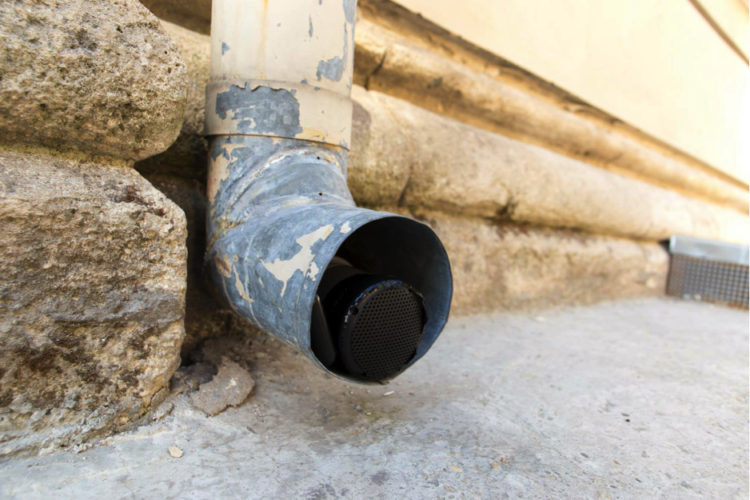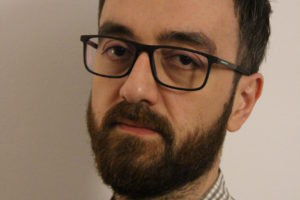If we take into account the reasons why we should choose the Old Centre of Bucharest for a go out, we would notice that they would vary between drinking / eating or walking / seeing something. Therefore one can see that there is an economic pre-conception regarding this space, which we use just for passage. How could it be “dwelled”? How could it be shared as a common good in an aesthetic experience? If we change the sound regime of the Old Centre, would its identity be released from tourism or cultural consumerism? If we block the absurd and irritating overlap of the latest musical hits, would we perceive it differently? In what kind of difference?
The project INSIDE-OUT, sound installations in public space, opens the possibility of a re-evaluation of the Old Centre. The curator and artist of this project, Antje Vowinckel, together with Maria Balabaș, have experimentally changed the sound of the Poștei street, the Franceză street – Curtea Veche and Sf. Anton Square, in order to temporarily wipe out their commercial destination and open them as common goods. The name of the project refers to the forgotten aspect of the Old Centre namely that of being a lived space with a ”interiority” extended by all those who participate in different ways to its life.
The installations naturally attracts the attention of any passer-by, because they play with a constitutive mechanism of the mind; everything we hear requires the elucidation of the causal liaison that is established between the sound and the objective context in which it was perceived (what I hear / who makes it/ what makes it). Furthermore this liaison generally involve the use of personal memory. Next thing I do when I hear something is recognizing from memory or direct perception the source of that sound. So if there is no relation of identity between what I hear and what I see, I am forced to search further to make other assumptions which finally converts my mental habits. By changing the streets sound environment these installations are essentially counter-habitual aiming to produce a disjuncture as to “free” them from the automatisms of common evaluation (a leisure area with “European” pedigree).
Antje Vowinkel is a Berlin artist who is experimenting with sound and radio art. Her works are using the musicality of the languages and the non-ostensive function of the recorded expression, making sound montages with fragments extracted from language courses or the dialects of a language. In Bucharest she uses the specific materiality of the places to reveal their latent musicality and identity.
On the Poştei Street she uses the water evacuation pipes because they “resemble the pipes of a pipe organ installed upside down only that they are silent.” I imagine that by placing the speakers and synchronizing the mp3 players within an interval of 10 seconds the artist wanted to trigger in the minds of the passers an active / conscious process of assimilation which at first seemed just free associations and overlaps of sounds. She is committed thus to: 1.) force the passers-by to see (in the literal sense of the word) the houses and not simple facades – the sounds are emitted near the ground and seem to come from inside of the houses; 2.) perform a kind of concert or a sound atmosphere suitable for a meditative public walk.
In the case of Curtea Veche she chooses to exploit the iron fence by installing interactive sensors that activates a series of sounds – previously recorded by manipulating materials / objects from the site and thus creating audible images of the space – that solicits from the bystanders a projective exploration. Each sensor is designed to activate different sounds: simple or rhythmic, in low or high tones, long or short. The interactive potential of the work is ludic and interesting; anyone can “compose”, through random movements near the sensors, a personalized partition of sounds. The idea of this installation is to generate /to promote a personal way of interaction with the space; to remove the place from the blind interaction of tourism (images, pictures and views) and propose it in all its materiality under the “whimsy” sound productions of any passer-by.
Maria Balabaș is a sound and radio artist established in Bucharest. She is interested in making sound installation from field recordings engaging the problematic of memory and identity. In this project, some recordings are used to relate the identity of the place to the memory of the bystanders. In Sf. Anton Square a series of small speaker were placed under the benches and set to replay recordings containing personal or observational details (taken same time ago in the same Square). At the entrance of the Square one can hear a diffuse buzz that then crystallizes according to the bank you choose to sit on. The idea of the artist is to produce a sound moulding of the space such as to increase its capacity for intimacy. Seated on the bench you are un-tied, thanks to the speakers, from the sound environment and let to freely associate what you see with what your memory conjures. The artist aims to initiate a process of negotiation / partaking / enrolment of everyone in the depersonalized and marketed narrative of the public space.
We know from Freud that something becomes strange to us only to the extent that we were once familiar with it, anguish is also present within this state of awareness. But how to make something familiar become suddenly estranged / unfamiliar and in the same time liberating? The sound installations have this capability, they capture the bystanders and have the ability to “estrange” the place due to the incongruity of the sounds with the ambient. This sound devices are liberating because they amend habits and open the possibility of questioning the use of the public space. It can be said that as artistic gestures the sound installations become also a subtle “environmental policy” that distributes the (sensible) space by already proposing it as a common good.
INSIDE-OUT may be the beginning of a negotiation regarding a community inscribed purpose for the Old Centre. The “reactive” capacity of the installations, to discharge the impersonal perception of the streets and share them as personal experiences, refers to the possibly unseen rapport between art and politics. I will recall Jacques Rancière‘s concept of “the distribution of the sensible” in a literal interpretation because it “establishes at one and the same time something common that is shared and exclusive parts. This apportionment of parts and positions is based on a distribution of spaces, times, and forms of activity that determines the very manner in which something in common lends itself to participation and in what way various individuals have a part in this distribution” and opens up the issue of the common goods that the present erases and the future can only imagine.
INSIDE-OUT – Installations of sound art; Sf. Anton Square, French Street and Poștei Street 10 -24 September. Made possible by Goethe Institute in collaboration with The National Museum of Romanian History and Bucharest Municipality Museum. Curator: Antje Vowinckel. Artists: Antje Vowinckel and Maria Balabaș.
POSTED BY
Emilian Mărgărit
Emilian Mărgărit is an independent curator and since 2017 founding member of Image and Sound, Bucharest. He has a PhD in Philosophy (contemporary French Philosophy), he has published in collective v...


Comments are closed here.